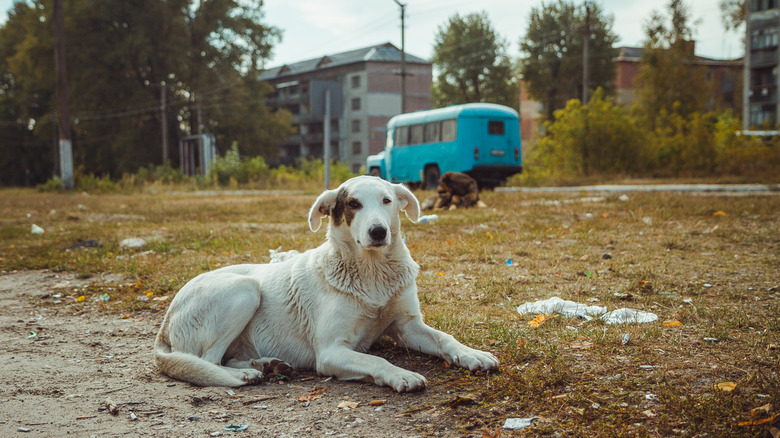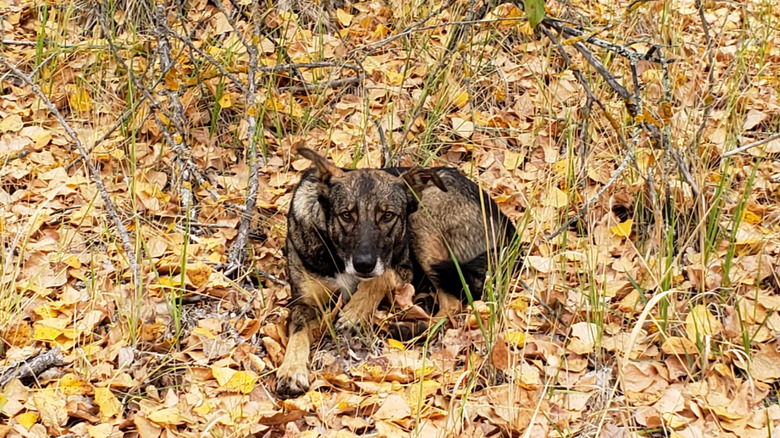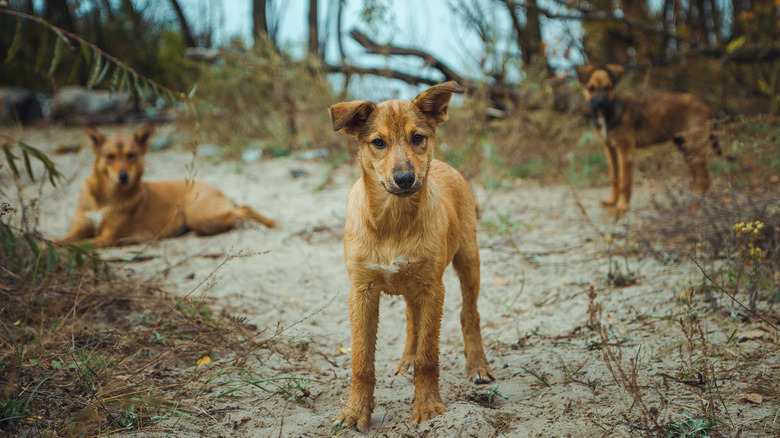Something Strange Is Happening With Chernobyl's Free-Roaming Dogs
The catastrophe that occurred at the Chernobyl Nuclear Power Plant near the then-Soviet Union city of Pripyat on April 26, 1986 remains the largest of its kind, both in its immediate impact and long-term ramifications. Its place in history is measured in the loss of life sustained and lasting effects on the region's people, along with changes to regulations for and the perception of nuclear energy by the masses. Before the Russia-Ukraine War, the over 18-mile exclusion zone became popular among "dark tourists" who visit sites associated with traumatic events. It saw unprecedented attention in 2019, with over 124,000 visitors, per Statista.
While Chernobyl's radiation levels only allow for short visits from humans, many animals live in or frequent the area, including free-roaming dogs. "The numbers of animals we see in Chernobyl is similar to the populations in uncontaminated nature reserves," Professor Jim Smith of the University of Portsmouth, who led a study into the wildlife in the region, shared with the BBC in 2015. The presence of these populations has drawn the interest of multiple scientists like Smith, especially those interested in researching the effects of long-term radiation exposure.
Timothy A. Mousseau, professor of biological sciences at the University of South Carolina, and Anders P. Møller of the French National Centre for Scientific Research highlighted several such studies around Chernobyl and Japan's Fukushima Daiichi Nuclear Power Plant accident in a 2014 article published in the Journal of Heredity. However, the research specific to canines remained inconclusive until 2023 and 2024 when new studies confirmed the feral dogs of Chernobyl have a distinct genetic makeup. Though the exact reasons for these differences remain uncertain, experts have put forward multiple possibilities.
The unique genetic makeup of Chernobyl's dogs
As part of a 2023 study printed in Science Advances, Timothy A. Mousseau and his team completed the first genetic analysis of the dogs of Chernobyl, which concluded that they have a distinct makeup compared to any other canine breed on record. While the exact history of the animals in the area has been marred by an inability to conduct research consistently after the catastrophe, various wildlife have reportedly lived there since the accident in 1986. Mousseau's group found 250 stray canines around the power plant, with hundreds recorded in the exclusion zone.
Despite the challenges stemming from the differences between wild and domestic dogs, the researchers got close enough to the canines to gather blood samples that established them as a hodgepodge of wide-roaming dogs. While the canines shared their ancestry predominately with German shepherds followed by Eastern European shepherds, they have a unique genetic makeup compared to other mixes living over 9 miles away in Chernobyl City. Due to decades of isolation, the results of the study raised a series of new questions.
Researchers still have much to learn about the dogs of Chernobyl
Speaking with the New York Times about Chernobyl's dogs, Elaine Ostrander, the study's senior author, raised the question, "Do they have mutations that they've acquired that allow them to live and breed successfully in this region?" While the research is inconclusive, in the same article, a canine geneticist with Cornell University College of Veterinary Medicine, Adam Boyko, spoke on the importance of the study, stating, "I don't think anybody has looked at a single, free-breeding dog population genetically at this level of detail before."
A study published at the end of 2024 in PLOS One by scientists at North Carolina State University and Columbia University Mailman School of Public Health in New York may have ruled out the possibility of genetic mutation through radiation. Dr. Matthew Breen, the paper's senior author, noted that they looked at the chromosomal level, genome level, and nucleotides of the Chernobyl canines and found no proof of abnormalities caused by radiation. Still, the team could not rule out other toxins affecting the dog's unique genetic makeup, with hazards like lead, heavy metals, and asbestos still on site. Alternatively, the team theorized that the current canines in the contamination zone may have already had unique genetic traits that allowed them to survive around the power plant after the disaster.
Due to the conflict brought on by the Russia-Ukraine war, visits to Chernobyl have been heavily restricted. However, potential future research into the unique genetics of the dogs of the area could provide scientists with insight into the effects of pollutants over a long period of exposure. With other recent studies, like what happens to their brain waves when humans and dogs connect, it is evident that we can still learn a lot about humanity's best friend.


